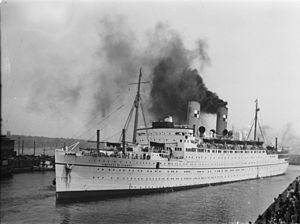Namesake Duchess of Richmond Yard number 523 Length 183 m | Port of registry London, UK Launched 18 June 1928 Builder John Brown & Company | |
 | ||
Operator Canadian Pacific Steamships Ltd | ||
SS Duchess of Richmond was an ocean liner built in 1928 for Canadian Pacific Steamships by John Brown & Company in Clydebank, Scotland. In 1947 she was renamed SS Empress of Canada.
Contents
Duchess
The Duchess of Richmond was one of the several Canadian Pacific liners which were known as the "Drunken Duchesses" for their lively performance in heavy seas." She was built as a sister ship to SS Duchess of York, SS Duchess of Bedford and SS Duchess of Atholl.
At midnight on Saturday, 26 January, 1926 she sailed from Liverpool to Freetown and back, on a cruise, calling in at
On board was the World Chief Scout, Lord Baden-Powell and his family; they attended Scout Rallies at each port. It may be that this was a "shake-down" cruise to test the ship.
In March 1929 the 20,022-ton ocean liner began transatlantic summer service from Montreal Canada to Liverpool in the United Kingdom with winter service out of the port of Saint John, New Brunswick, Canada. On 27 April 1929, she ran aground at Saint John. Her passengers were taken off, and she was refloated the next day.
Troopship
,
During World War II, the Duchess was requisitioned as a troopship, and also played a role in transporting the Tizard Mission, which brought secret military equipment and designs from Britain to the United States. On September 6, 1940, she delivered the Mission, including highly secret and important equipment such as the cavity magnetron, to Halifax, Nova Scotia, Canada. The Mission then went onward by land to the United States. She also transported men to the fighting in North Africa, stopping briefly in Algiers to disembark troops on November 14, 1942.
Empress
War losses reduced the Canadian Pacific fleet considerably and post-war only the Liverpool to Montreal service was resumed. The two surviving cabin class Duchesses were upgraded to "Empress" status and refitted with accommodation for 400 1st class and 300 tourist passengers (down from the pre-war three class total of 1,570). In May 1946 "Duchess of Richmond" arrived at the Govan yard of Fairfield Shipbuilding and Engineering for her overhaul and refit. Upon completion she was renamed Empress of Canada on July 12, 1947 and sailed on Canadian Pacific's first post-war Liverpool-Montreal sailing four days later.
On 25 January 1953 Empress of Canada caught fire and heeled over against the dock wall at Gladstone Dock, Liverpool. Re-floated after being righted by parbuckling, the following spring she was taken to La Spezia, Italy where she was scrapped. The difficulty of her recovery has been likened to that of the ocean liner SS Normandie in New York Harbor in 1942 and the United States Navy battleship USS Oklahoma at Pearl Harbor in 1943.
